#logperch
Text


two common log perch individuals
percina darters are SO cool & I wish I could see all of them
#common logperch#darters#conservation#nature#ichthyology#native fish#freshwater fish#fishing#fishblr#fish#biology#wildlife
237 notes
·
View notes
Text
🐟 Mercraft: Fish Mode! A (mostly) complete guide ^^
New Order of the Stone: (all are species found in Minecraft)
Jesse- cod
Lukas- dolphin
Petra- sockeye salmon
Axel- sea turtle
Olivia- squid
Reuben- sea pigckle /j clownfish
Dewey- pufferfish

Blaze Rods:
Aiden- jaguar cichlid
Gill- he’s the only human /j snakehead probably
Maya- rainbow smelt
Old Order of the Stone:
Gabriel- North Atlantic swordfish
Ellegaard- Argentine shortfin squid
Magnus- dwarf sawfish
Soren- common cuttlefish
Ivor- blue-ringed octopus
Witherstorm- giant squid or kraken “Ichorstorm”

Portal Arc:
Isa- rainbow darter
Milo- banana eel
Reginald- fantail darter
Benedict- oyster “Eversoyster”
Harper- East Pacific red octopus
PAMA- arapaima “AraPAMA”
Hadrian- shovelnose sturgeon
Otto- brook trout
Mevia- vampire squid
Cassie- brindled madtom
Nell- mahi-mahi
Em- bull shark
“Tim”- great white

Champion City:
Radar- logperch
Stella- emperor angelfish
Lluna- narwhal
Sea Temple:
Jack- lemon shark
Vos- oarfish
Sammy- flying fish
Nurm- mirror carp
Prismarine Colossus- coelacanth
Elder Guardians- sacabambapsis

Sunshine Institute + Underneath:
Warden- lamprey
Oxblood- goliath tigerfish
Carmine- goblin shark
Binta- whale shark

Admins:
Romeo- lionfish (+crab armor)
Fred- blue jellyfish (+clam armor)
Xara- pelagic stingray (+starfish armor)
“Vos”- anglerfish
Snowmeo- crocodile icefish

I know there are characters I missed; if you want to ask about someone, please do! I’d be happy to assign them a fish! Also if you want to know the reasoning behind any of these choices, I’m happy to answer! I will discuss fish choices ALL DAY. (Ex. Most engineers or scientists were assigned species of octopus/squid because having more arms is useful.) :]
The Mercraft: Fish Mode tag just started out as the MC:SM equivalent of Mermay for me but y’all are free to use it even if you have differing fish ideas for the characters! Bonus: Aiden and Radar’s concepts can be found here!
#started this yesterday and my poor camera roll is now an ocean#mcsm#minecraft story mode#only tagging the new order because these are just teeny sketches#mcsm jesse#mcsm lukas#mcsm petra#mcsm axel#mcsm olivia#bermuda brainrot hours#scriptscratches#mercraft fish mode
99 notes
·
View notes
Text
Good News - April 1-7
Like these weekly compilations? Support me on Ko-fi! Also, if you tip me on here or Ko-fi, at the end of the month I’ll send you a link to all of the articles I found but didn’t use each week - almost double the content! (I’m new to taking tips on here; if it doesn’t show me your username or if you have DM’s turned off, please send me a screenshot of your payment)
1. Three Endangered Asiatic Lion Cubs Born at London Zoo
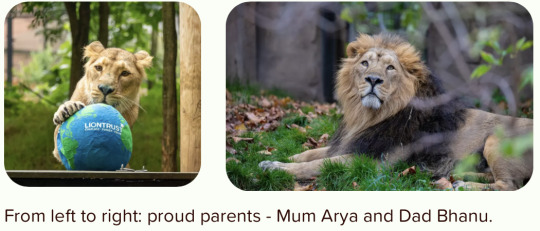
“The three cubs are a huge boost to the conservation breeding programme for Asiatic lions, which are now found only in the Gir Forest in Gujarat, India.”
2. United Nations Passes Groundbreaking Intersex Rights Resolution

“The United Nations Human Rights Council has passed its first ever resolution affirming the rights of intersex people, signaling growing international resolve to address rights violations experienced by people born with variations in their sex characteristics.”
3. Proposal to delist Roanoke logperch

“Based on a review of the best available science, the U.S. Fish and Wildlife Service (Service) has determined that the Roanoke logperch, a large freshwater darter, is no longer at risk of extinction. […] When the Roanoke logperch was listed as endangered in 1989, it was found in only 14 streams. In the years since, Roanoke logperch surveys and habitat restoration have more than doubled the species range, with 31 occupied streams as of 2019.”
4. Fully-Accessible Theme Park Reopens Following Major Expansion

“Following the $6.5 million overhaul, the park now offers [among other “ultra-accessible” attractions] a first-of-its-kind 4-seat zip line that can accommodate riders in wheelchairs as well as those who need extra restraints, respiratory equipment or other special gear.”
5. ‘The Javan tiger still exists’: DNA find may herald an extinct species’ comeback
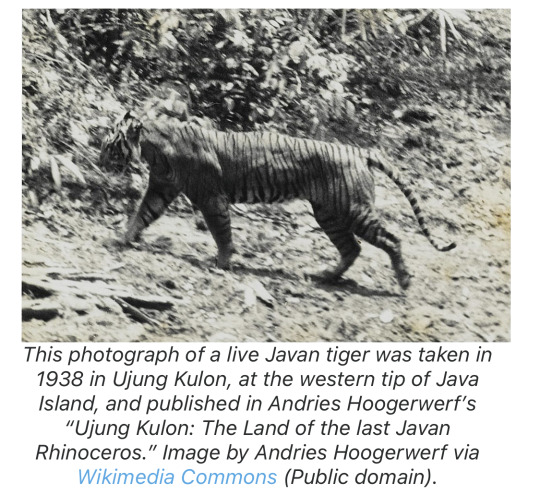
“A single strand of hair recovered from [a sighting] is a close genetic match to hair from a Javan tiger pelt from 1930 kept at a museum, [a new] study shows. “Through this research, we have determined that the Javan tiger still exists in the wild,” says Wirdateti, a government researcher and lead author of the study.”
6. Treehouse Village: Eco-housing and energy savings

““The entire place is designed and built to meet the passive house standard, which is the most energy-efficient construction standard in the world,” says resident Wayne Groszko, co-owner of one of the units at Treehouse.”
7. 50 rare crocodiles released in Cambodia's tropical Cardamom Mountains
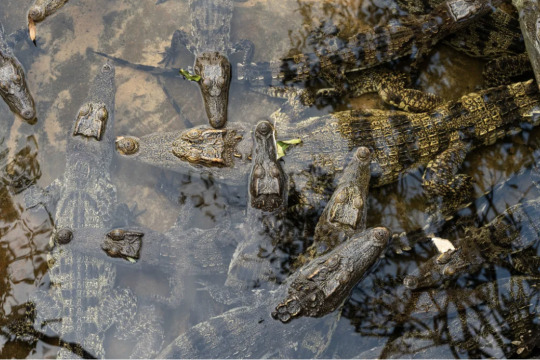
“Cambodian conservationists have released 50 captive-bred juvenile Siamese crocodiles at a remote site in Cambodia as part of an ongoing programme to save the species from extinction.”
8. The Remarkable Growth of the Global Biochar Market: A Beacon of Environmental Progress

“Biochar, a stable carbon form derived from organic materials like agricultural residues and forestry trimmings, is a pivotal solution in the fight against global warming. By capturing carbon in a stable form during biochar production, and with high technology readiness levels, biochar offers accessible and durable carbon dioxide removal.”
9. 'Seismic' changes set for [grouse shooting] industry as new Scottish law aims to tackle raptor persecution

“Conservation scientists and campaigners believe that birds such as golden eagles and hen harriers are being killed to prevent them from preying on red grouse, the main target species of the shooting industry. […] Under the Wildlife Management and Muirburn Bill, the Scottish grouse industry will be regulated for the first time in its history.”
10. White House Awards $20 Billion to Nation’s First ‘Green Bank’ Network

“At least 70 percent of the funds will go to disadvantaged communities, the administration said, while 20 percent will go to rural communities and more than 5 percent will go to tribal communities. […] The White House said that the new initiative will generate about $150 billion in clean energy and climate investments[…].”
March 22-28 news here | (all credit for images and written material can be found at the source linked; I don’t claim credit for anything but curating.)
#hopepunk#good news#lion#conservation#zoo#india#intersex#lgbt rights#human rights#fish#endangered#disability#accessibility#amusement park#tiger#big cats#extinction#extinct species#ecofriendly#affordable housing#energy efficiency#crocodiles#global warming#climate change#scotland#raptor#eagles#hunting#solar panels#solar energy
7 notes
·
View notes
Text
all the fish we got I think:
bluegill
pumpkinseed
crappie
smallmouth
largemouth
perch
northern pike
white sucker
golden redhorse
shorthead redhorse
northern hogsucker
logperch
yellow bullhead
golden shiner
6 notes
·
View notes
Photo



The Logperch were making it impossible to catch any suckers! That being said, I was really happy to have caught these lovely fish
#fish#fishing#logperch#common logperch#creek fishing#catch and release#country#nature#outdoors#wildlife#biodiversity
43 notes
·
View notes
Photo



The Conasauga Logperch (Percina Jenkinsi)
Status: Endangered
To learn more, visit: https://ecos.fws.gov/ecp/species/8472
#conasauga logperch#percina jenkinsi#fish#fishing#endangered species#endangered#pretty#scaly#aquatic#aquatic animals#the animal kingdom#learn more
1 note
·
View note
Text


Common logperch | Percina caprodes
Photo credit: x, x
94 notes
·
View notes
Note
PA anon here, thanks for answering my question! I hope you don't mind a follow-up since attempting to search the Google:tm: didn't quite give me the detail I wanted. All of the fish you listed were lovely! Would it be possible to keep a large community tank with a majority of them? Out of the Sunfish I'm most interested in the Pumpkinseed, but I'm unsure if they'll eat any of the fish on this list or be too aggressive, and I saw you mention Sticklebacks are also best kept in a species only tank?
Not a problem! Happy to share additional, only sometimes requested opinions with others (it IS the internet after all!).
So there are two questions here - we’ll do the community one first. A community tank would be fine here, but you should consider which species you want to focus on. I don’t usually like putting madtoms and darters in the same tank because they compete and both are pretty poor at fighting for food. My personal opinion is that you get better behavior out of schooling fish when you have one big school rather than three smaller schools, but it depends on the size of your tank (in a 55, I’d suggest 8-10 of one species rather than 4-5 of two). Pumpkinseed are probably going to be aggressive with Bluespotted Sunfish, but are pretty mild as adults as far as sunfish go. If you had a 55, for example, a singleton Pumpkinseed, a singleton Logperch, and 6-7 small minnows would make a fine tank. If you have a tank size in mind, I could help further.
Sticklebacks are peculiar. They are both aggressive and a bit on the frail side - they will nip at similar sized fish but are easily preyed upon or damaged by larger fish, which makes finding good tankmates really hard. When kept among themselves, you can see breeding displays and defending of territory on full display, which makes that the way to go for keeping these animals.
3 notes
·
View notes
Text
Oh, the Concho watersnake (Nerodia paucimaculata)? An imperiled snake species endemic only to a small distribution range in streams and riparian habitats near the confluence of the Concho and Colorado rivers in the savanna and prairies of the Rolling Plains ecoregion of West Texas between San Angelo and Killeen? The snake that famously angers oil and gas corporation executives of West Texas?

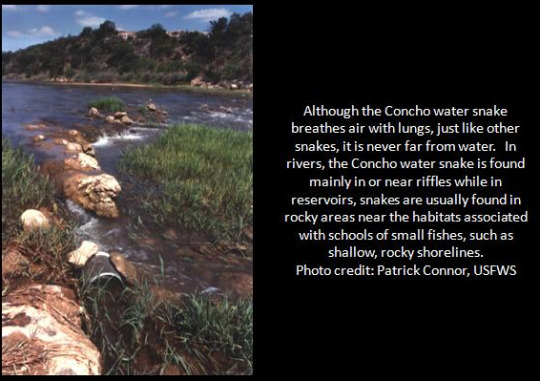
The Concho watersnake was formally listed as a threatened species in 1986, apparently in large part due to devastation of its riparian habitat; the snake was removed from the list of threatened species in 2011 (to the celebration of land developers).
On how artificial dam infrastructure degraded the snake’s habitat:
“Historically, the Concho Water Snake occurred over about 276 river miles of the Colorado and Concho Rivers in central Texas. [...] The Concho Water Snake is endemic to Texas, which means it lives nowhere else in the world. It has one of the smallest distributions of any North American snake. [...] The Concho Water Snake may once have been more widely distributed, but the E.V. Spence Reservoir upstream and Lake Buchanan downstream have inundated many miles of river habitat at both ends of the current range. [...] Larger trees and shrubs, such as pecan, cedar elm, and willow, with limbs that hang over water, provide basking sites for juveniles and adults. Common bank and shoreline vegetation used for cover and basking sites include switchgrass, devil-weed aster, greenbrier, poison ivy, willow, saltcedar, button bush, hackberry, pecan,cedar elm, and mesquite.” [Source: Texas Parks & Wildlife Department.]
Sorry for bad quality of the map:
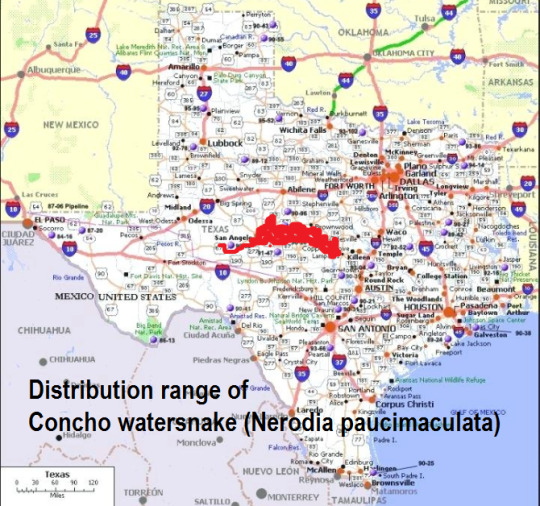
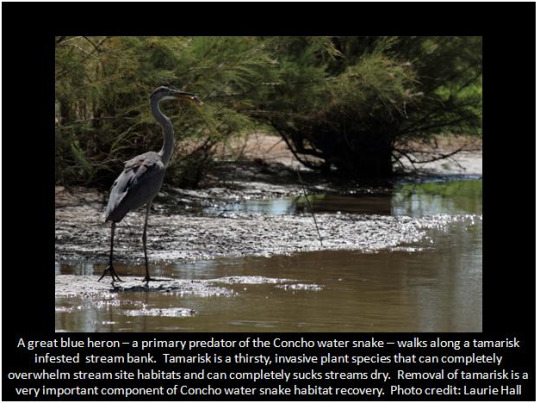
Ulmus crassifloia, the cedar elm, an important species in the watersnake’s habitat:
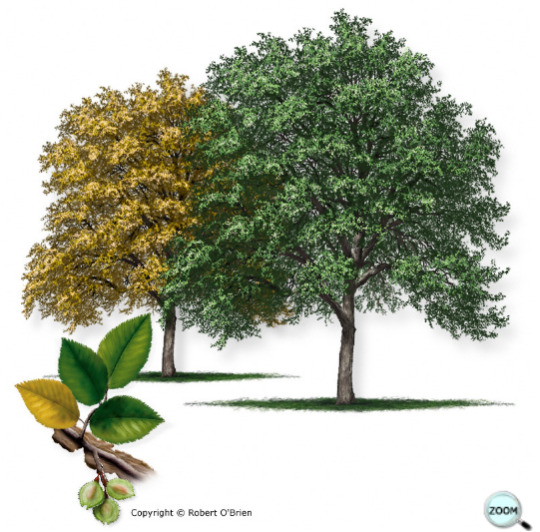
Excerpt from: “Rally puts spotlight on impact of listing lizard as endangered species.” Mella McEwen for Midland-Reporter Telegram. 26 April 2011.
[The president of the Permian Basin Petroleum Association] called the issue [of potentially halting some fracking to save endangered reptile habitat] “one of the most important issues facing the oil and gas industry and West Texas.” [...] The stakes are also high for the nation, he said, because the listing would eliminate oil and gas operations in the nation’s most prolific oil and gas producing region. [...] J*mes B*auch*mp, president of the Motran Alliance, worked for Rep. Ch*rlie St*nholm when the Concho water snake was listed, an event that almost ended efforts to construct Lake Ivie. “Had it not been for construction of Lake Ivie in 1995, we [humans? resource extraction lobbyists?] might be the endangered species.”
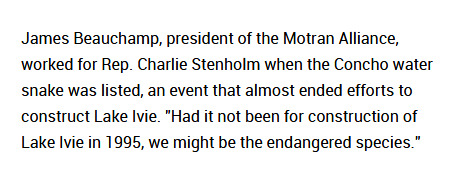
Five population units of the species [“Population Dynamics of the Concho Water Snake in Rivers and Reservoirs.” Martin J. Whitting, et al. 2008.]:
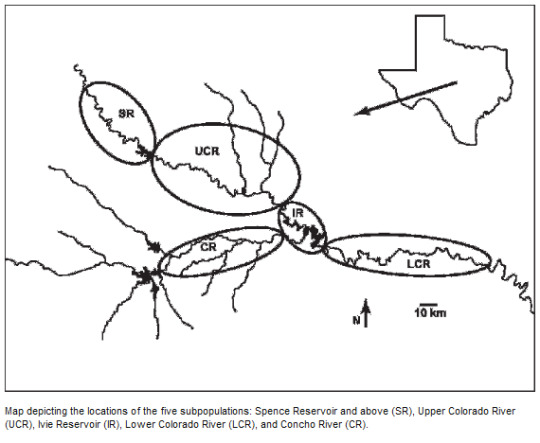
From Texas State Historical Society: “The O. H. Ivie Reservoir, once called Stacy Reservoir, is impounded by the S. W. Freese Dam at the Concho-Coleman county line. It is located in Concho, Coleman, and Runnels counties. In 1938 the United States Army Corps of Engineers expressed a desire for a reservoir site near the confluence of the Concho and Colorado rivers. An agreement was finally reached in 1985, when the Texas Water Commission granted permission to impound 554,000 acre-feet of water on the Colorado River at Stacy, sixteen miles below the confluence. The project was delayed by negotiations to preserve the endangered Concho water snakes [...].“
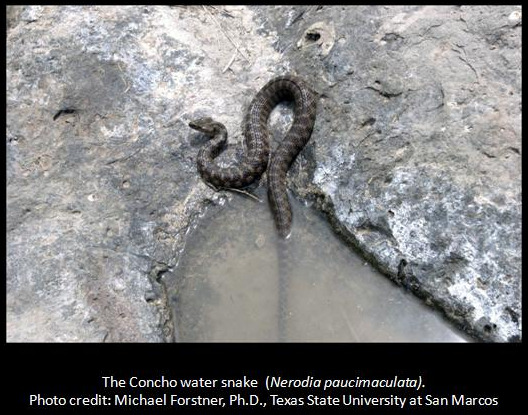
More fun ecology, from Texas Parks & Wildlife Department:
Historically, the Concho Water Snake occurred over about 276 river miles of the Colorado and Concho Rivers in central Texas. The snake was first [described by Euro-American taxonomists] from the South Concho River and Dove Creek, which are tributaries to the Concho River west of San Angelo, Texas. When the subspecies was described in 1961, these records and one other on the Colorado River south of Robert Lee in Coke County were the only known localities for this snake.[...] The probable historic range of this snake is estimated to include, at a minimum, the Colorado River from Spence Reservoir down-stream to the vicinity of Lake Buchanan, Elm, Bluff, and Coyote Creeks (Runnels County), and the entire Concho River (Tom Green and Concho Counties) and its headwater tributaries. [...]
Large snakes consume mosquitofish, channel catfish, flat-head catfish, gizzard shad, and several species of sunfish. The bullhead minnow, sheepshead minnow, and bigscale logperch were found to be the dominant prey of snakes in Ballinger Municipal Lake. [End excerpt.]

#watersnake performed direct action against Texas land development#was reading an article today and some Texas oil guy was interviewed and talked about how he still hated Concho watersnakes
160 notes
·
View notes
Text
Lindsey Bridge River Project, Madison 09.08.20
0 notes
Text
0 notes
Note
Not about ur aus but......
HOPE YOU FEEL BETTER SOON!

Thank you! ^^ I really do appreciate it! 💙
Headaches are gone so it’s back to drawing.



More MC:SM merfolk requests! Guess who…
Species are lionfish, sockeye salmon, coelacanth, jaguar cichlid, and logperch!
15 notes
·
View notes
Text
Neogobius melanostomus: A Well “Rounded” Case Study for the Great Lakes Region

In recent history, numerous invasive aquatic species have travelled to the Laurentian Great Lakes and brought with them a host of environmental, economic, and social problems. Round goby, aka Neogobius melanostomus (pictured above), has joined creatures such as zebra mussels, sea lamprey, and phragmites on the long list of organisms than have set up shop in the Great Lakes region despite the fact that they definitely aren’t supposed to be there. So, let’s talk about round goby, the damage they cause, and the potential lessons we can learn from them.
First discovered in the Great Lakes region in the St. Clair River in 1990, the round goby has covered a lot of ground: they now occupy all five Great Lakes and have entered the mouths of many connected rivers as well. Like their fellow invaders, the zebra mussel, the round goby is native to the Caspian Sea, Black Sea, and the Sea of Azov in Eastern Europe. Coincidentally, most managers believe that the two arrived in the Great Lakes in the same way: in the ballast water discharge from international shipping vessels.

These little fish aren’t very striking: young gobies tend to be gray, while older fish are mottled black and brown. Their pelvic fins are fused, acting like a suction cup so that the fish may hold on to stones. The only notable markings they have is the single spot on their first dorsal fin. However, insignificant as they may look, they have had disastrous consequences for the Great Lakes’ native fishes.
What’s so bad about round goby?
Round gobies are ravenous eaters of native fishes and their young. Goby feed on young fish and fish eggs, causing declines smaller native fishes (like sculpins, darters, and logperch) and sport fishes. In addition to preying on small native fishes, goby also compete with them for food and habitat.
Round goby can easily adapt their appetites to fit whatever food source is most abundant, which in many cases is zebra mussels (picture below, encroaching on a native mussel). While this may seem like a positive aspect, this means that goby have a greater number of possible food sources to pull from, allowing them to outcompete native fishes.
There is also concern over the round goby’s abilities to act as a vector for disease and toxins. How is this possible?
1. Zebra mussels can act as hubs for avian botulism. As round gobies consume mussels, they may distribute the neurotoxin to birds that consume them
2. When gobies consume mussels, they may acquire sediment related toxins that could be transferred to predators higher up on the food chain

Who cares?
I imagine that, by this point, you may be tired of hearing about invasive species in the Great Lakes. I completely understand. Our beloved Great Lakes have become so inundated with disruptive organisms that it can be very easy to dismiss one more fish that decided to hitchhike. After all, if you don’t fish, why should you care about round goby?
While it easy to think about invasive species in ecological or environmental terms, the tendrils of their impact often extends far beyond the lakes that they inhabit. For Great Lakes states, a thriving fish population is the lifeblood of a healthy economy. According to the Department of Natural Resources at Cornell University, recreation fishing has an estimated value range of $393 million to $1.47 billion per year in the Great Lakes region (and this is in 2012 dollars!). This value is not restricted to the fish themselves, rather, it expands into the tourist industry that has been built around fishing in the Great Lakes. Every time someone decides to take a fishing trip, not only do they buy a license and fishing gear, they also purchase gas, food, and lodging. Many towns around the Great Lakes have been built on the foundation of a healthy fish population.
These benefits extend to people who commercially fish the Great Lakes as well (pictured below). The value of fish sold by state and tribal commercial operations is estimated to be worth 10-12 million dollars per year in the state of Michigan, with the overall impact on the economy estimated to be 4-5 times greater. While there are far fewer commercial fishers than recreational ones, commercial fishers bring their own value to their communities. For example, in this Great Lakes Now video Net Income, a commercial fisher-woman reports that commercial fishing can offer crucial access to protein for those who lack the money, time, or physical ability to go fishing themselves.

What can we do about round goby?
Unfortunately, according to the Michigan Department of Natural Resources, the round goby is here to stay. Given that the gobies live on the floors of the lakes and there is no way to control them without hurting other fish, there is little that can be done to get rid of them. Currently, natural resource managers are more concerned with preventing round goby from spreading to other bodies of freshwater. If you would like to know how you can help, here’s how:
· If you come across Round Goby in a water body, and you are unsure if it has been documented there before, report it to your local conservation author
· don’t use round goby as bait-live round goby are illegal bait in Great Lakes states
· if you are using live bait, dispose of it properly
· wash boating and angling equipment after each use
· tell your neighbors about round goby and the effects they can have

Next Steps:
If there is a lesson to take from the proliferation of the Round Goby, it is one of preparation. It is no secret that humans have irreversibly affected the world around us, and invasive species such as the round goby add on to that long list of examples. However, we still have the potential to learn from our mistakes. The beautiful thing about scientific research is that we can use the data we have amassed from studying round goby and other invasive species to ensure to the best of our abilities that invasions will not happen again. In addition, we can choose to support policies the protect our native ecosystems.
According to an article published in Annual Review of Environment and Resources, preventing invasive species from entering new habitat is more cost-effective policy than attempting to get rid of them after the fact. While it is too late for us to do this with round goby, speaking to your local and state representatives about these issues can prevent history from repeating itself. You can advocate for some of the below actions to be taken in order to keep the Great Lakes great.
· Regulations on the trade of live organisms (this could include the pet or agricultural trade)
· Monitoring of modes of transportation that could potentially carry invasive species, both internationally and locally
· Monitoring of highly trafficked areas so invasive species can be detected early
· International agreements to prevent the movement of invasive species

Some of these ideas are already being addressed. For example, the National Invasive Species Act of 1996 was created, in part, to stop ships from spreading invasive species with ballast water (which is what got this whole round goby issue started to begin with). Part of what set this off was the invasion of zebra mussels which were first sited in the Great Lakes in 1988, 2 years before round goby. Perhaps if some of the above strategies had been implemented with gusto after the mussels were first found, our present situation would have been avoided and we would not be talking about round goby.
If you are interested in learning more about round goby, invasive species, or the importance of healthy fish populations, please feel free to check out the sources I used (listed below). I also encourage you to do some investigating of your own!
References:
David M. Lodge, Paul W. Simonin, Stanley W. Burgiel, Reuben P. Keller, Jonathan M. Bossenbroek, Christopher L. Jerde, Andrew M. Kramer, Edward S. Rutherford, Matthew A. Barnes, Marion E. Wittmann, W. Lindsay Chadderton, Jenny L. Apriesnig, Dmitry Beletsky, Roger M. Cooke, John M. Drake, Scott P. Egan, David C. Finnoff, Crysta A. Gantz, Erin K. Grey, Michael H. Hoff, Jennifer G. Howeth, Richard A. Jensen, Eric R. Larson, Nicholas E. Mandrak, Doran M. Mason, Felix A. Martinez, Tammy J. Newcomb, John D. Rothlisberger, Andrew J. Tucker, Travis W. Warziniack, Hongyan Zhang. 2016. Risk Analysis and Bioeconomics of Invasive Species to Inform Policy and Management. Annual Review of Environment and Resources 41:1, 453-488.
Poe, G.L., T.B. Lauber, N.A. Connelly, S. Creamer, R.C. Ready, and R.C. Stedman. 2013. Net benefits of recreational fishing in the Great Lakes Basin: A review of the literature. HDRU Publ. No. 13-10. Dept. of Nat. Resour., N.Y.S. Coll. Agric. and Life Sci., Cornell Univ., Ithaca, N.Y. 79 pp.
https://www.youtube.com/watch?v=qrC6KYJ_bb0
https://nas.er.usgs.gov/queries/FactSheet.aspx?speciesID=5
https://nas.er.usgs.gov/queries/FactSheet.aspx?speciesID=713
https://www.michigan.gov/dnr/0,4570,7-350-79136_79236_80538_80541-424724--,00.html
https://www.michigan.gov/documents/deq/wrd-ais-neogobius-melanostomus_499884_7.pdf
https://tucanada.org/stop-the-spread-the-round-goby/
https://pdfs.semanticscholar.org/c8f5/bbfeecaeb8d3a7ca41a8271eda58b41f22b3.pdf
https://www.congress.gov/bill/104th-congress/house-bill/4283/text/enr
0 notes
Text

Percina carbonaria, Texas logperch
Photo by Nick Loveland
31 notes
·
View notes
Text
I am going to be receiving back my collection of wet preserved forage fish specimens now that my collection and report have been graded, but the thing is... I don't know what to do with 16 pickled fish. They're cool, I don't want to discard them. But keeping them in a box in my closet is lame. Do I set up a dead fish shelf? That seems somehow wierder than my animal bone collection.
6 notes
·
View notes
